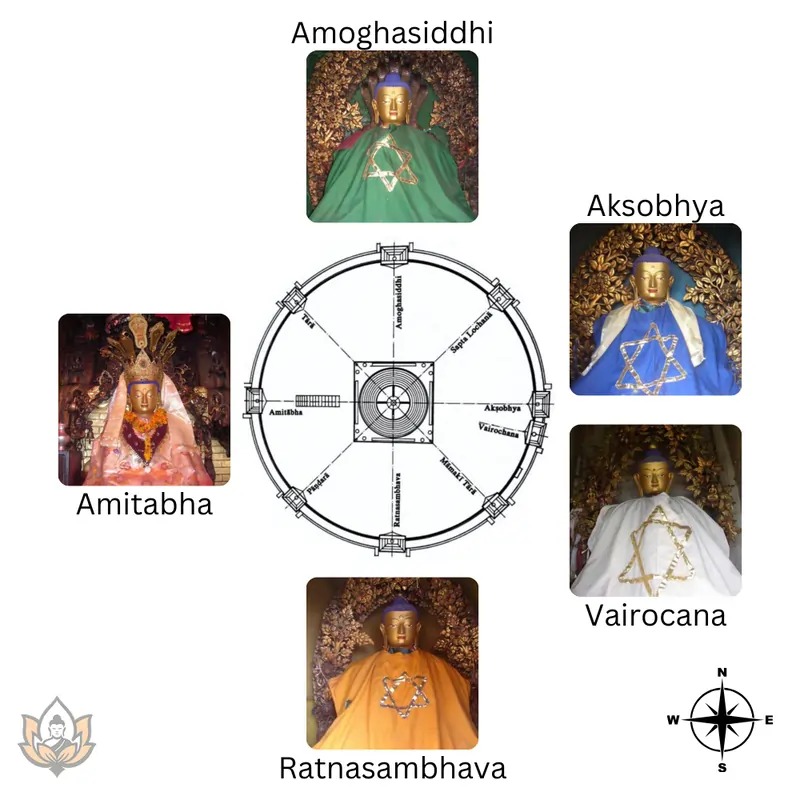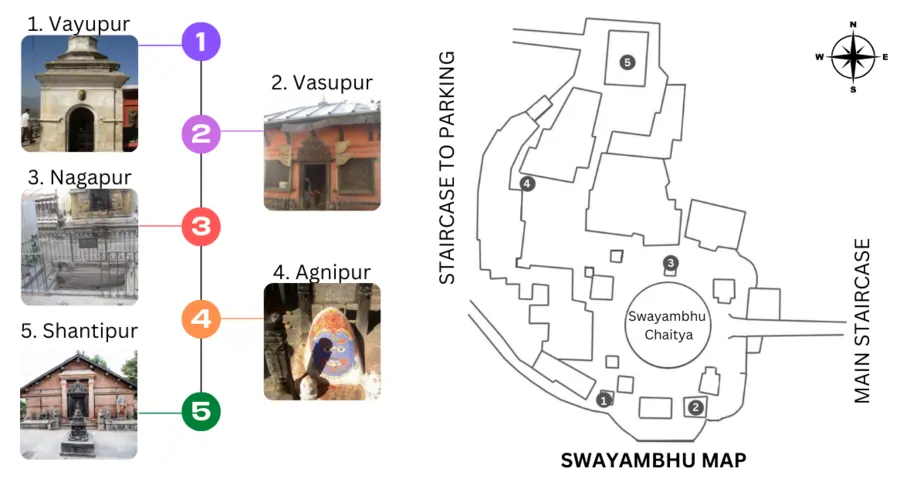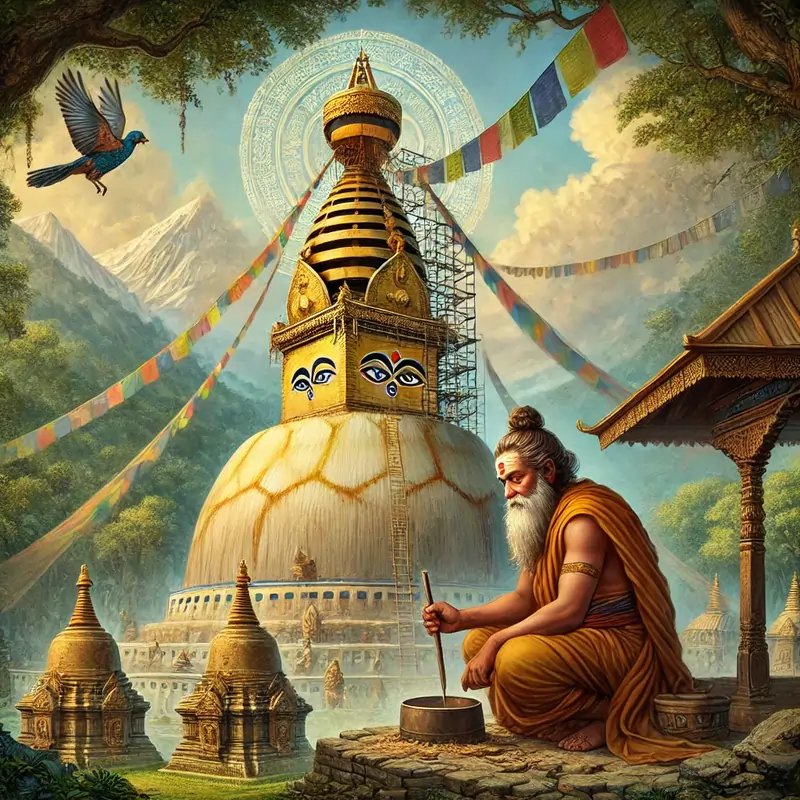The Emergence of Kashyapa Tathagata
In this way, after Kanakarmuni Tathagata had passed from his life, Kashyapa Tathagata (कश्यप तथागत) was manifested in the lineage of the Buddhas as the Sixth Buddha to appear on earth for the protection of all sentient beings. During that period, it was believed that the human lifespan spanned twenty thousand years (Dvapara Yuga – द्वापर युग). The sacred abode of Kashyapa Tathagata was established in a place called Mrigadava (Deer Park), which corresponds to present-day Varanasi, India. His disciple Jyotiraja (Lord of Light) Bodhisattva was prophesied to be reborn in a future age as Shakyamuni Buddha. It was recounted that this marked the dawn of the Dvapara Yuga.
The Celestial Gathering and the Noble Sermon
One day, the seat for the sermon was occupied by Kashyapa Buddha, and beings from every realm were said to have assembled before him: Brahma, Indra, legions of gods, lords of all spheres, planets, stars, constellations, celestial nymphs, demigods, demons, serpents, falcons, sages, pilgrims, celibates, Buddhist devotees, Brahmins, Kṣatriyas, kings, ministers, Vaiśyas, heads of armies, merchants, craftsmen, businessmen, rural and urban folk, the Vaishnavas, and countless other beings. All worship and salutations were offered to Kashyapa Buddha. Then the multitude took their seats, facing him with reverence.
The Noble Faith equipped with the means of Perfect Enlightenment was expounded by Kashyapa Buddha for the benefit of the past, present, and future, beginning with Satya Yuga. Upon hearing this teaching, all those assembled were awakened and wished to achieve prosperity and happiness. They began to carry out the discipline of the Bodhicarya (the path of enlightened conduct).
Manjushri’s Chaitya at Swayambhu Hill
In those days, Manjushri Bodhisattva (मन्जुश्री बोधिसत्त्व) was residing upon the Vajrakuta Parvata (present-day Swayambhu Hill, Kathmandu) in a human incarnation named Manjudeva, alongside his two wives, Mokshada and Varada. After residing there for a long period, Manjudeva wished to return to MahaChin (present-day China) to regain his divine form. His plan was fulfilled when he and his wives entered into Samadhi, and their disciples cremated their earthly bodies. A Chaitya was erected over the remains at the spot where they had lived. This monument, known as Manjushri Chaitya, still existed on the lower peak of Swayambhu Hill in Kathmandu and was also called Manjushri Hill ( See in Map). It was believed that those who worshiped and devoted themselves to this shrine of Manjushri would receive the qualities of dharma. Those who desired the virtues of Manjushri were advised to praise and revere the Manjushri Chaitya.

A King’s Renunciation: Prachandra Deva of Gauda
Much later, a king named Prachandra Deva (प्रचण्ड देव) was born in the Kingdom of Gauda (present-day Bengal, India), descended from the lineage of Vajradhara. Prachanda Deva was regarded as deeply devout, ethical, and prudent in his governance, guiding his subjects toward a righteous dharma. One day, the king realized that despite the world’s great beauty, all existence would inevitably end. Age would weaken every organ, ailments and diseases would prevail, and death would ultimately claim all life.
A decision was then made by the king to abandon the palace life and its pleasures and to seek solitude in the forest. He announced to his ministers and well-wishers that his son, Prince Shakti Deva, would become the next king. Thus, he implored everyone to uphold dharma and remain prudent in all matters of state.
Pilgrimage to the Himalayas and the Vision of Swayambhu
King Prachandra Deva first embarked on a life of solitude in the forest, engaging in meditation. However, he soon realized that personal liberation without contributing to the welfare of other beings was meaningless. Therefore, he left the forest and traveled to various pilgrimage sites and holy places. Eventually, he reached the Himalayas and beheld the Swayambhu Dharmadhatu.
Devotional worship was offered by him to the Swayambhu Dharmadhatu through eight bodily prostrations, meditation, and the chanting of mantras. Next, he caught sight of the Manjushri Chaitya, which was praised and saluted through hymns and stotras. His journey then continued toward the Great Goddess Khaganana Nairatyma (Guheswari), where he worshiped, saluted, and praised her with numerous hymns. He also visited the Bagmati River and other sacred sites, bathing and adoring the eight vitaragas (अष्ट वीतराग – Manichuda, Gokarna, Kileshvara, Kumbheshvara, Garteshvara, Phanikeshava, Gandhesvara and Vikrameshvara), to whom he offered salutations and praises.
The Birth of Shantashri Bhiksu
Prachanda Deva finally arrived before Bodhisattva Gunakar Acharya (गुणाकर आचार्य), who was known as a follower and student of Manjushri. Prachandra Deva expressed his desire to stay at Swayambhu under the guidance of Gunakar Acharya. In response, Gunakar Acharya ordained Prachandra Deva into the dharma and granted him the Bodhicarya vow, instructing him to practice for the welfare of the world.
The king’s head was shaved, and he donned the civara robe, formally becoming a great monk. From that day onward, he was known as Shantashri Bhiksu (शान्तश्री भिक्षु).
Shantashri’s Mission to Protect the Swayambhu Dharmadhatu
One day, Shantashri gazed at the Swayambhu Dharmadhatu atop the lotus flower and began to wonder how long it would last. He realized that during the Dwapara Yuga, people still followed some principles of Dharma. However, in the Kali Yuga, when corruption would completely overtake humanity, preserving the sacred Light of the Self-Existent would become very challenging.
To safeguard the Dharmadhatu, Shantashri decided it must be hidden inside a rock and a chaitya (stupa) built over it. Seeking permission from his guru, Gunakar Acharya, Shantashri explained his plan. Guru Gunakar agreed but told him that before taking on such a sacred responsibility, he must perform the religious ritual of Vajrabhisheka (now also known as Vajracharyabhisheka) and practice Vajrayana.
Following his guru’s guidance, Shantashri underwent the Vajrabhisheka ritual and received the Vajracharya vow from Gunakar. From that day onward, Shantashri became known as Shantashri Vajracharya (शान्तश्री बज्राचार्य), Shantikar Vajracharya (शान्तिकर बज्राचार्य), Shantikar Acharya (शान्तिकर आचार्य) or Shantikaracharya (शान्तिकरचार्य), dedicating himself to protecting the sacred Dharmadhatu.

Concealing the Swayambhu Dharmadhatu
Shantikar Acharya proceeded to construct a Chaitya over the Swayambhu Dharmadhatu (Self-Existent Light). A hole was dug in the ground, and the Dharmadhatu was placed within it. The hole was then covered with a precious stone that had a small opening at its center, allowing the Light of the Self-Existent to radiate. Next, a hemispheric cupola, called the Garbha (गर्भ – womb), was constructed from stone and brick. Also known as the Anda (egg), this Garbha was revered as a center of the earth’s creative forces, which were nurtured and then channeled upward through the spire (often referred to as the “Tree of Life”) to project them into the universe.

Above the Garbha, the square Harmika (हर्मिका) was raised and surmounted by a Spires of thirteen levels, topped by a Golden Umbrella. The Harmika was recognized as the Sanctuary, the base of the Tree of Life, and a symbol of the Noble Eightfold Path. The thirteen discs of the spires corresponded to the thirteen mystical powers of the Buddha.

In the northeast side of the Garbha (egg) and upon its top, holes were made to connect directly to the Dharmadhatu so that offerings could be received by the Light itself. There are statues of Five Buddha (Pancha Buddha) on each side of Chaitya. On the eastern side of the Chaitya, an image of Aksobhya Buddha (अक्षोभ्य बुद्ध), seated on an elephant and showing the earth-touching mudra (gesture), was placed, representing mirror-like wisdom. At the center, near the eastern side where Aksobhya Buddha stood, an image of Vairocana Buddha (वैरोचन बुद्ध), mounted on a lion and expressing the mudra of the wheel, was consecrated, signifying Dharmadhatu wisdom. On the southern side, an image of Ratnasambhava Buddha (रत्नसम्भव बुद्ध), mounted on a horse and expressing the mudra of giving, was enshrined, symbolizing the wisdom of equality. On the western side, an image of Amitabha Buddha (अमिताभः बुद्ध), mounted on a peacock and expressing the mudra of meditation, was placed, signifying discriminative wisdom. On the northern side, an image of Amoghasiddhi Buddha (अमोघसिद्धि बुद्ध), mounted on a garuda and showing the mudra of fearlessness, was installed, representing all-accomplishing wisdom. On each side of the Chaitya, flags bearing sacred Mantras and Dharanis were attached.

Manjushri Chaitya and the Five Element Temples
In the same way, the Manjushri Chaitya was covered with rocks by Shantikar Acharya, and a stupa was constructed atop it. A formal ritual was performed to establish this stupa as sacred. Furthermore, Shantikar Acharya built temples dedicated to the five elements:
- Vayupur – वायुपुर (Wind), with an image of Vayudev,
- Vasupur – वासुपुर (Earth), with an image of Vasundhara Devi,
- Agnipur – अग्निपुर (Fire), with an image of Agnidev,
- Nagapur – नागपुर (Water), with an image of Nagadev,
- Akasapur – आकसपुर (Sky), also called Shantipur (शान्तिपुर), with an image of the virtuous MahaShrimatSambara (महाश्रीमत्सम्बर).
Below is a brief overview of the blessings that were believed to be bestowed upon devotees who worshiped each deity and Bodhisattva:
- Worshipers of Vayudev
- Were believed to remain free from rheumatism.
- Devotees of Agnidev
- Were thought to remain unharmed by fire and safeguarded from ailments.
- Worshipers of Nagadev
- Were assured they would not suffer from drought and would acquire wealth and jewels.
- Adorers of Vasundhara Devi
- Were said to be spared from poverty and distress.
- Followers of Sambara (सम्बर) Bodhisattva
- Were rewarded with immense prosperity, gentleness, virtue, comfort, and happiness.
- Those who devoted themselves to the Chaitya of Manjushri (Manjudeva)
- Were believed to gain dharma, prosperity, and happiness, and to be released from misfortunes, misdeeds, and enemies.


Shantikar Vajracharya’s Accomplishments
Shantikar Vajracharya was said to have attained great renown, prosperity, and complete mastery of knowledge. He became a revered Acharya and Bodhisattva. Afterward, he withdrew into deep meditation on the Namasangiti, along with the recitation of Mantras and Dharanis. Through Yogacharya practice, he became recognized as Trikaljnani, the knower of the past, present, and future. A multitude of disciples gathered around him, and the shrine in which he resided came to be known as Shantipur ( See in Map) in his honor. By acquiring numerous Siddhis, including the Pranayama technique of ceasing breath, it was decided by him to enter Samadhi and remain in the Shantipur temple eternally.
Swayambhu Purana – Table of Contents
« Chapter 6: Kanakamuni Tathagata: Dharmadhatu Vagishwara
Chapter 8: Blessings of Shakyamuni Buddha »

